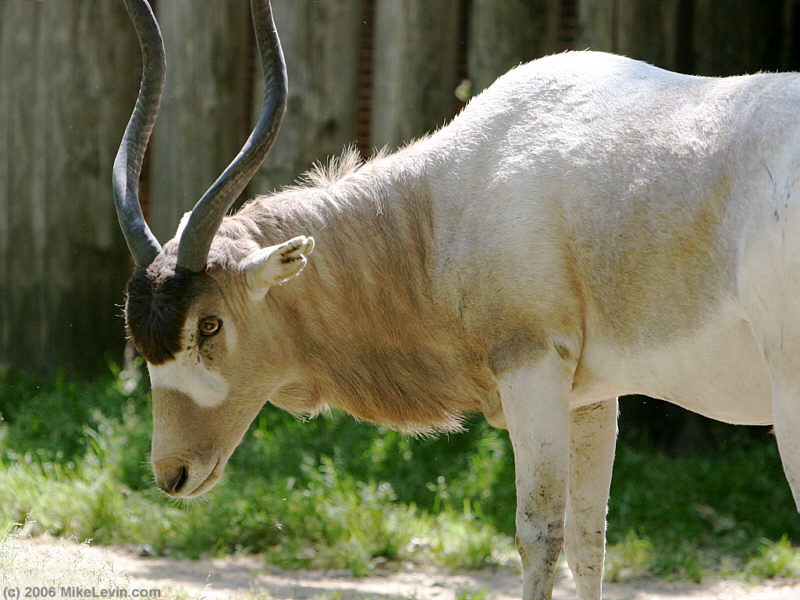Tuesday, 22 March 2011
CITES Species: Addax
The Addax (Addax nasomaculatus), also known as the screwhorn antelope, is a critically endangered species of antelope that lives in the Sahara desert. As suggested by its alternative name, this pale antelope has long, twisted horns. It is closely related to the oryx, but differs from other antelopes by having large square teeth like cattle and lacking the typical facial glands. Although extremely rare in its native habitat due to unregulated hunting, it is quite common in captivity. They are sometimes hunted as trophies on ranches in the United States.
The Addax stands about 1 metre (3.3 ft) at the shoulder and its weight varies rom 60 to 120 kilograms (130 to 260 lb). The coloring of their coat varies with the season. In the winter it is greyish brown with white hind quarters and legs. In the summer, the coat turns almost completely white or sandy blonde. Their head is marked with brown or black patches that form an X over their nose. They have a scraggly beard and prominent red nostrils. Long black hairs stick out between their curved and spiraling horns ending in a short mane on the neck. Horns, found on both males and females, have two to three twists and can reach 80 centimetres (31 in) in females and 120 centimetres (47 in) in males. Their tail is short and slender, ending in a puff of hair. The hooves are broad with flat soles and strong dewclaws to help them walk on soft sand.
Addax live in desert terrain where they eat grass, and leaves of what shrub and bushes are available. They are amply suited to live in the deep desert under extreme conditions. Addax can survive without free water almost indefinitely, because they get moisture from their food and dew that condenses on plants. Scientists believe that the addax has a special lining in its stomach that stores water in pouches to use in times of dehydration.
Addax herds contain both males and females and have from two to twenty animals, though they had more in previous times. They will generally stay in one place and only wander widely in search of food. Addax have a strong social structure, probably based on age, and herds are led by the oldest male. Herds are more likely to be found along the northern edge of the tropical rain system during the summer and move north as winter falls. Addax are able to track rainfall and will head for these areas where vegetation is more plentiful. Interestingly, Addax are nocturnal and rest during the day in depressions they dig for themselves.
In ancient times, addax occurred from Northern Africa to Arabia. Pictures from Egyptian tombs show them being kept as domesticated animals in around 2500 BC. The population of addax is today a mere fraction of what it once was and this dramatic decrease is mainly attributed to over-hunting. These slow-moving animals provide easy targets, particularly with motorized vehicles and automatic weapons, and their meat and leather are prized by local people. Other factors involved in the decline include desertification, drought and habitat encroachment by pastoral expansion and subsistence agriculture. It is estimated that fewer than five hundred individuals survive in the wild today, with the bulk of these lying between the Termit area of Niger and the Bodélé region of Western Chad.
The addax is listed on Appendix I of the Convention on International Trade in Endangered Species (CITES), thus prohibiting international trade. Provided effective protection is granted for the last remaining pockets of populations, it is possible that the species can increase. With this in mind, the Sahara Conservation Fund has developed a regional strategy that when implemented will protect the remaining wild populations and facilitate the recolonisation of neighbouring suitable habitats.
A protected population exists in the Yotvata Hai-Bar (Wildlife Preserve) Nature Reserve in Israel, to the north of Elat. The reserve was set up in 1968 with the view to bolster populations of endangered desert species. In Niger, a vast protected area is being established in the Termit region to protect the largest remaining addax population in the wild. There are currently around 2,000 individuals in captive populations around the world and these are being used in reintroduction programmes for the species in Tunisia and Morocco.
Source: Wikipedia, Arkive, CITES
Subscribe to:
Post Comments (Atom)






No comments:
Post a Comment
Many thanks for your contribution. Where applicable, we will respond to you here.